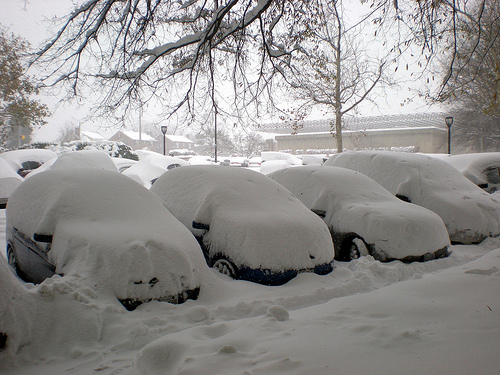
As the country watches Hurricane Isaac’s massive spiral head straight for the Gulf Coast, we are all experiencing post-traumatic symptoms of Katrina, which, seven years ago today, was heading for the same target. But I’m also remembering a severe weather event that hit closer to home (for me) somewhat more recently: Snowpocalypse, followed by Snowmageddon, followed by Snoverkill. The three storms hit DC during the winter of 2009-2010, dumping a combined 55 to 72 inches of snow on the area (depending which airport you measure from).
I’m not comparing Isaac’s capacity for devastation to these snowstorms, but I do wonder if there are some comparisons.
That winter, I was working at WTOP, the DC area’s news/traffic/weather radio station. We were working overtime and much of the staff was sleeping at a nearby hotel to ensure they could get to the newsroom. (Most of them commuted in from surprisingly distant suburbs.) One of the more significant tasks we were assigned was fielding calls from people whose power was out. Dedicated to holding the utilities accountable, WTOP reporters tracked the places where the companies hadn’t yet gotten the power back up and aired the grievances of the people affected.
Those people were out of patience. They called in from the farthest reaches of the region, irate that they were stuck in their homes, two feet of snow blocking their driveways, with no heat and no light and an indoor temperature hovering around 45 degrees. They felt abandoned and vulnerable. I felt for them – but I also couldn’t help but notice how our different choices left us in very different situations.
I was living in a small apartment in Adams Morgan, a central neighborhood in DC with buried power lines. (Although calls to bury above-ground power lines recently hit a fever pitch in DC, 65 percent of the city’s lines actually are underground – mostly in downtown areas.) As a result, our power never went out.
We didn’t have a car, so there was nothing to dig out. I just tucked my rain pants into my boots and trekked around, and when I wasn't staying at the hotel near the newsroom I would walk the three miles to work since bus service was limited (i.e. for days after the storms, buses wouldn’t go up big hills).
Many of the independent establishments in my neighborhood were open because the owners and employees lived nearby and could also walk to work. They took it as a point of pride that they could serve their customers during a trying time like that.
Other urban neighborhoods whose power did go out faced shorter restoration times than less dense areas. Power companies start upstream in targeting their restoration efforts, concentrating first on hospitals, senior centers, and other places where outages could be life-threatening. Then they move to power hubs and substations, moving downstream with the idea of restoring power as quickly as possible to the most people – meaning people in less-dense areas often have to wait longer. The fact that power companies have to thread their big trucks down snowy cul-de-sacs over such a wide area to restore power lines that extend ever further into the exurbs is a testament to the public costs of sprawl.
Often, those unplowed suburbs were simply inaccessible to the utility trucks, since snow-plowing also gets to more central locations first. Those snowbound streets meant the people in the outer suburbs had to wait extra long for service and it also meant a far more serious form of stranding than in the city. People who depended on their cars for every outing because nothing is accessible by foot – either because they live in places where the roads are designed for cars with no pedestrian infrastructure or because there are no amenities within walking distance – were, for all intents and purposes, stuck in their freezing cold homes.
It struck me how much more resilient my urban lifestyle was. I lived in a central, dense neighborhood where the city had invested in more expensive infrastructure (buried power lines), and it was worth it because it benefited so many people. Even through unplowed snow, I could get everywhere I needed to go by walking (and they were amusing journeys, let me tell you). My work, my social life, and my electric service were never interrupted.

I’ll never forget walking down a bright white 18th Street toward Dupont Circle with people streaming onto the street from every block. Despite the large numbers of people, the street was quieter than usual because there were no cars, and the noise there was was festive. Through 16 inches of snow, thousands of people marched to the circle to join in a massive snowball fight.
I hope stranded people in the suburbs also found community, even if in smaller numbers, even if somewhat less deliriously exuberant.
I wonder if the lessons I learned about density and resilience during the snowstorms of 2009-2010 apply in the Gulf Coast now. I don’t know where their power lines are buried and where they’re not. You can't plow rain. But walking short distances through flooded streets is probably a lot easier than long distances, and I bet that in urban areas there are more nearby places to seek refuge if water is coming in your house. Regardless, I'm hoping that this storm weakens quickly and that the damage is minimal everywhere, urban and rural.





